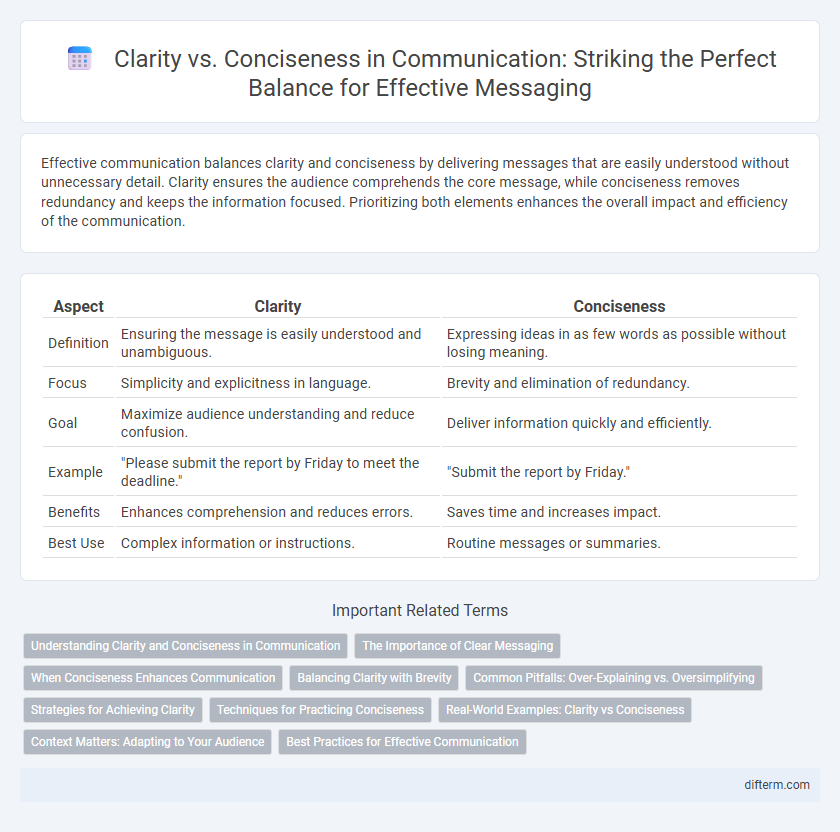Effective communication balances clarity and conciseness by delivering messages that are easily understood without unnecessary detail. Clarity ensures the audience comprehends the core message, while conciseness removes redundancy and keeps the information focused. Prioritizing both elements enhances the overall impact and efficiency of the communication.
Table of Comparison
| Aspect | Clarity | Conciseness |
|---|---|---|
| Definition | Ensuring the message is easily understood and unambiguous. | Expressing ideas in as few words as possible without losing meaning. |
| Focus | Simplicity and explicitness in language. | Brevity and elimination of redundancy. |
| Goal | Maximize audience understanding and reduce confusion. | Deliver information quickly and efficiently. |
| Example | "Please submit the report by Friday to meet the deadline." | "Submit the report by Friday." |
| Benefits | Enhances comprehension and reduces errors. | Saves time and increases impact. |
| Best Use | Complex information or instructions. | Routine messages or summaries. |
Understanding Clarity and Conciseness in Communication
Clarity in communication ensures the message is easily understood by using precise language and well-structured sentences that eliminate ambiguity. Conciseness requires delivering information briefly without sacrificing important details, which helps maintain the audience's attention and enhances message retention. Balancing clarity and conciseness improves overall comprehension, minimizes misunderstandings, and promotes effective information exchange.
The Importance of Clear Messaging
Clear messaging in communication prevents misunderstandings by delivering information that is straightforward and easy to interpret, enhancing overall effectiveness. Prioritizing clarity over excessive conciseness ensures that critical details are conveyed without ambiguity, catering to diverse audiences. This approach fosters trust, improves engagement, and streamlines decision-making processes across all communication channels.
When Conciseness Enhances Communication
Conciseness enhances communication by eliminating unnecessary words, allowing the core message to be conveyed quickly and effectively, which is crucial in fast-paced environments like business meetings or digital platforms. Clear, concise communication reduces the risk of misunderstandings and keeps the audience engaged by focusing on essential information. In technical writing and executive summaries, conciseness improves clarity by emphasizing key points without overwhelming the reader with extraneous details.
Balancing Clarity with Brevity
Balancing clarity with brevity in communication ensures that messages are easily understood without unnecessary detail. Effective communicators prioritize essential information while eliminating redundancies to maintain focus. This approach enhances engagement and reduces misinterpretation risks.
Common Pitfalls: Over-Explaining vs. Oversimplifying
Effective communication balances clarity and conciseness by avoiding over-explaining, which can overwhelm the audience with unnecessary details, and oversimplifying, which risks omitting critical information. Common pitfalls include providing excessive background that dilutes the main message or stripping content to the point where key nuances are lost, leading to misunderstandings. Mastering this balance ensures messages are clear, precise, and retain essential meaning for better audience engagement.
Strategies for Achieving Clarity
Strategies for achieving clarity in communication include using precise vocabulary tailored to the audience's knowledge level and avoiding ambiguous terms that can cause confusion. Structuring information logically with clear headings and concise sentences enhances understanding by guiding the recipient through key points effectively. Employing examples, visual aids, and feedback loops further reinforces the message and ensures accurate interpretation.
Techniques for Practicing Conciseness
Effective techniques for practicing conciseness in communication include eliminating redundant words, using precise language, and structuring sentences to convey maximum meaning with minimal words. Utilizing active voice and avoiding jargon further enhance clarity while maintaining brevity. Regularly reviewing and editing content ensures messages are clear, concise, and impactful.
Real-World Examples: Clarity vs Conciseness
Clarity in communication ensures that complex instructions in medical settings prevent errors, while conciseness in emergency broadcasts delivers vital information swiftly to save lives. For instance, airline cockpit communication relies on clarity to avoid misunderstandings, whereas news alerts use conciseness to quickly inform the public. Balancing clarity and conciseness enhances effective messaging in diverse real-world scenarios.
Context Matters: Adapting to Your Audience
Effective communication requires balancing clarity and conciseness by adapting to the audience's context and knowledge level. Tailoring messages based on the listener's background ensures that essential information is neither oversimplified nor overly detailed. Prioritizing context-sensitive language enhances understanding and engagement while minimizing misinterpretation.
Best Practices for Effective Communication
Effective communication balances clarity and conciseness by delivering precise information without unnecessary detail. Using simple language, avoiding jargon, and structuring messages logically enhance understanding and retention. Emphasizing key points and tailoring content to the audience's needs ensures messages are both clear and succinct.
clarity vs conciseness Infographic

 difterm.com
difterm.com